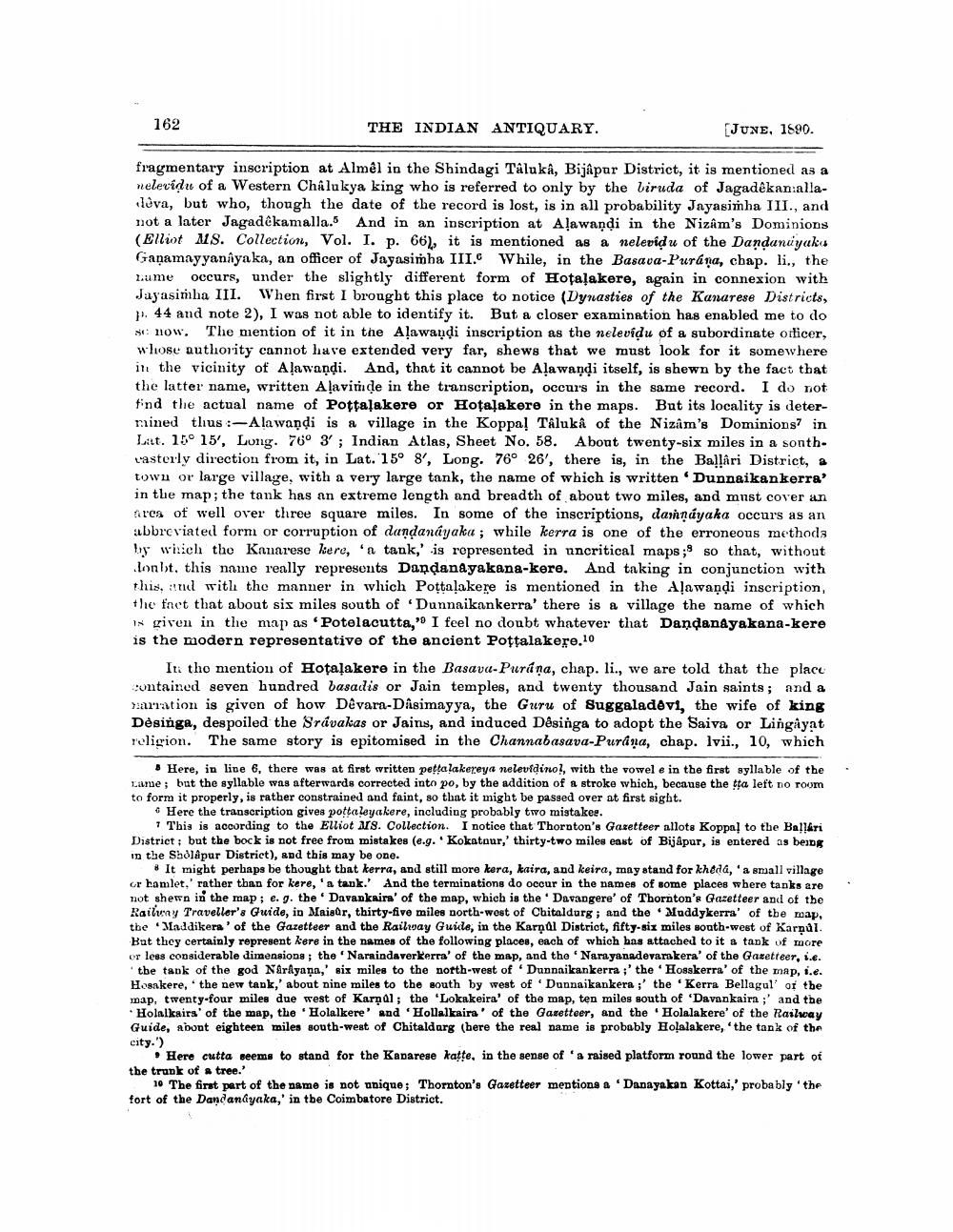________________
162
THE INDIAN ANTIQUARY.
[JUNE, 1890.
fragmentary inscription at Almêl in the Shindagi Taluka, Bijapur District, it is mentioned as a neleridu of a Western Chalukya king who is referred to only by the liruda of Jagadekanalla
leva, but who, though the date of the record is lost, is in all probability Jayasimha III., and not a later Jagadêkamalla. And in an inscription at Alawandi in the Nizâm's Dominions (Elliot MS. Collection, Vol. I. p. 66), it is mentioned as a nelevid u of the Dandaniyak. Ganamayyanayaka, an officer of Jayasimba III. While, in the Basava-Purana, chap. li., the nume occurs, under the slightly different form of Hotaļakere, again in connexion with Jayasimha III. When first I brought this place to notice (Dynasties of the Kanarese Districts, p. 44 and note 2), I was not able to identify it. But a closer examination has enabled me to do Se now. The mention of it in the Alawandi inscription as the nelevidu of a subordinate oificer, whose authority cannot have extended very far, shews that we must look for it somewhere in the vicinity of Alawandi. And, that it cannot be Alawandi itself, is shewn by the fact that the latter name, written Aļavitide in the transcription, occurs in the same record. I do not find the actual name of Pottalakere or Hotaļakere in the maps. But its locality is determined tlus:-Alawandi is a village in the Koppa! Taluka of the Nizam's Dominions in Lat. 15° 15', Lung. 76° 3' ; Indian Atlas, Sheet No. 58. About twenty-six miles in a sonth. vasterly direction from it, in Lat. 15° 8', Long. 76° 26', there is, in the Ballari District, a town or large village, with a very large tank, the name of which is written Dunnaikankerra' in the map; the tank has an extreme length and breadth of about two miles, and must cover an area of well over three square miles. In some of the inscriptions, damnáyaka occurs as an abbreviated form or corruption of dandanayaka ; while kerra is one of the erroneous methods by wirich tho Kanarese kere, 'a tank,' is represented in uncritical maps ;9 so that, without lonbt, this name really represents Dandanayakana-kere. And taking in conjunction with this, and with the manner in which Pottalakere is mentioned in the Alawandi inscription, the fact that about six miles south of Dunnaikankerra' there is a village the name of which is given in the map as 'Potelacutta," I feel no doubt whatever that Dandanayakana-kere is the modern representative of the ancient Pottalakere.10
In tho mention of Hotalakere in the Basava-Purana, chap. li., we are told that the place contained seven hundred basadis or Jain temples, and twenty thousand Jain saints; and a marration is given of how Dêvara-Dasimayya, the Guru of Suggaladevi, the wife of king Desinga, despoiled the Srávakas or Jains, and induced Dêsinga to adopt the Saiva or Lingayat religion. The same story is epitomised in the Channabasava-Purana, chap. lvii., 10, which
• Here, in line 6, there was at first written pettalakereya nelevidinol, with the vowel e in the first syllable of the Lame; but the syllable was afterwards corrected into po, by the addition of a stroke which, because the tta left no room to form it properly, is rather constrained and faint, so that it might be passed over at first sight.
1 Here the transcription gives potta leya kere, including probably two miste
7 This is according to the Elliot 18. Collection. I notice that Thornton's Gazetteer allots Koppal to the Balleri District; but the bock is not free from mistakes (e.g. 'Kokatour,' thirty-two miles east of Bijapur, is entered as being in the Sholapur District), and this may be one.
# It might perhaps be thought that kerra, and still more kera, kaira, and keira, may stand for kheda, 'a small village cr hamlet,' rather than for kere, 'a tank. And the terminations do occur in the names of some places where tanks are not shewn in the map ; e.g. the 'Davankaira' of the map, which is the 'Davangere' of Thornton's Gazetteer and of the Railway Traveller's Guide, in Maisur, thirty-five miles north-west of Chitaldurg; and the Muddykerra' of the map, the Maddikera' of the Gazetteer and the Railway Guide, in the Karnal District, fifty-six miles south-west of Karnůl. But they certainly represent here in the names of the following n the names of the following places, each of which has attached to it a
attached to it a tank of more or less considerable dimensions; the 'Naraindaverkerra' of the map, and the 'Narayanadevarakera' of the Gazetteer, 1.€.
the tank of the god Narayana,' six miles to the north-west of Dunnaikankerra ;' the Hosskerra' of the map, i.e. Honkere, the new tank,' about nine miles to the south by west of Dunnaikankera ;' the 'Kerra Bellagul' or the ipap, twenty-four miles due west of Karnal; the 'Lokakeira' of the map, ten miles south of 'Davankaira ;' and the * Holalkairs' of the map, the 'Holalkere' and 'Hollalkaira' of the Gazetteer, and the 'Holalakere' of the Railway Guide, abont eighteen miles south-west of Chitaldarg (here the real name is probably Holalakere, 'the tank of the city.')
Here cutta seems to stand for the Kaparese katte, in the sense of a raised platform round the lower part of the trunk of tree.'
1. The first part of the name is not unique; Thornton's Gazetteer mentions a 'Danayakan Kottai, probably the tort of the Dandanayaka,' in the Coimbatore District.




